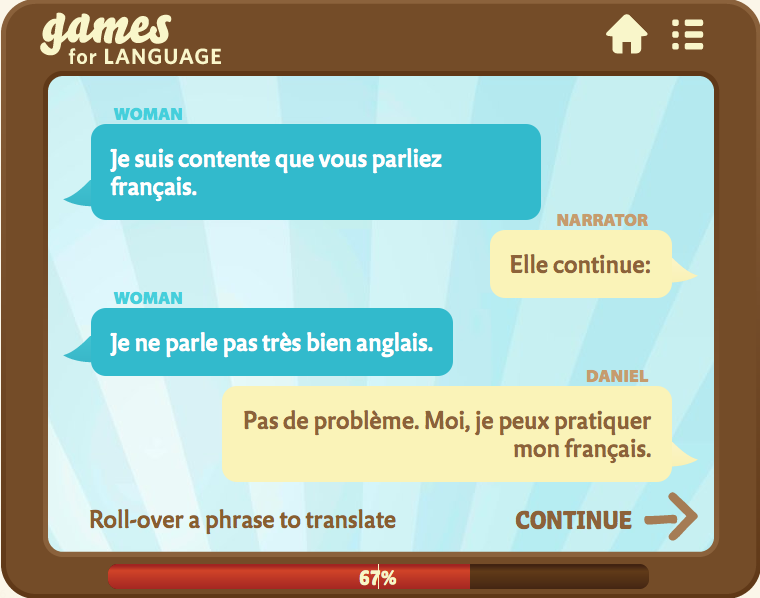Why Context is Essential for Language Learning
 Context is essential for language learning, no doubt about that. But why?
Context is essential for language learning, no doubt about that. But why?
Recently I read again Steve Kaufmann's post Meaningful Context in Language Learning. He tells the story of a Chinese family.
The family immigrated to Canada 12 years ago when the daughter was 4 years old. She is now 16 and speaks English fluently, while her parents still have great difficulties and can't speak English well at all.
Steve traces their lack of English language skills to the fact that “English is not very important to them. [...] They don’t have a strong sense of wanting to participate in an English-speaking society so there isn’t that context of wanting to participate in the language, but context goes beyond that.”
Clearly, lack of exposure to the new foreign language – as so often happens in immigrant enclaves in all countries – may well be the main reason the parents in Steve's anecdote never learned to speak English fluently.
In their daily lives, English did not occur in a “meaningful context for them,” and that may explain why they were not motivated to learn.
Why immigrants learn or do not learn the language of their new country is a complicated question. It involves issues of time and money, stresses of daily life, problems with assimilation, integration into the local community, the language used at work, availability of resources, etc. All or any of these may hold a person back from becoming functionally fluent in a new language.
Comprehensible Input
 Steve Kaufmann argues that to get beyond just the basics of a language, a learner has overcome personal hurdles and also learn with interesting “comprehensible input.”
Steve Kaufmann argues that to get beyond just the basics of a language, a learner has overcome personal hurdles and also learn with interesting “comprehensible input.”
That means being exposed to language materials that are relevant, that “resonate” with a person's interests.
With all the technology available these days, you can be pretty much in control of your own language learning, though sometimes this may be a hit-or miss process to find your level.
To get the right kind of exposure to your new language, you can set up the right context for learning your new language by reading books and articles, listening to audios, watching films and videos that genuinely interest you.
But just LISTENING alone will not let you learn a new language unless you have a way of figuring out what the sounds and words of the new language mean. Whatever you're listening to has to be comprehensible - language that you understand, at least about 80% of it.
“The Story” and Games
 Our approach at GamesforLanguage is one way of providing “comprehensible input.” We teach vocabulary and grammar structures with short games and “The Story” - a sequential and connected series of dialogues and short narratives that tell of a young man's travels in one of four European countries.
Our approach at GamesforLanguage is one way of providing “comprehensible input.” We teach vocabulary and grammar structures with short games and “The Story” - a sequential and connected series of dialogues and short narratives that tell of a young man's travels in one of four European countries.
While the different games help the learner to practice all four skills (listening, reading, writing, and speaking), the dialogues and narratives introduce and repeat grammatical structures, which he or she will recognize and/or, at times, be alerted to.
For example, already in the second Scene (lesson) of our French 1 Story,  we bring in the subjunctive, with the sentence “Je suis contente que vous parliez...” in our dialogue (see image).
we bring in the subjunctive, with the sentence “Je suis contente que vous parliez...” in our dialogue (see image).
We then briefly explain the form “vous parliez” in our “Deal no Deal?” game (see image).
Twenty Scenes later, the expression “je suis contente” is used again, but with the subjunctive of another verb.
Will we teach all subjunctive forms of these particular verbs? No, but the learner is alerted to the context in which such forms are used and will soon start to recognize new subjunctive forms as they come up.
The Limitation of Flashcards
I love flashcards and we use them in our games. Learning vocabulary is clearly necessary and flashcards are a great tool for that.
But simply memorizing lists of words is not enough to really understand and speak a foreign language. Individual words are the building blocks. But you need to know how to build sentences with them and how these relate to each other in a conversation.
The goal is to internalize how the language works for communication, in other words, the grammar patterns that govern speech. That is best done in context. In addition, you have to understand what language fits into the given context.
Why Context Matters - An Example for French
Taking a sample French “core conversation,” in our French 1 course, I'd like to show how learners would focus on different aspects of the language at different stages of their learning, and why context is important:
In this short dialogue, a young man, Daniel, is at the home of a friend. There he meets Mathilde for the first time.
 Daniel: Bonjour Mathilde, enchanté de faire votre connaissance.
Daniel: Bonjour Mathilde, enchanté de faire votre connaissance.
Virginie: Daniel, ne sois pas si formel. Vous pouvez vous tutoyer!
Daniel: Ça ne te dérange pas, Mathilde?
Mathilde: Bien sûr que non.
Hello Mathilde, delighted to meet you.
Daniel, don't be so formal.
You (two) can say “tu” to each other!
You don’t mind, Mathilde?
Of course not.
Initially you may mostly focus on:
• Individual words and phrases
• Learning their meaning
• Practicing their pronunciation and spelling
• Finding a way to practice the sentences
(Speak them aloud, type or write them out, hang the page up in the kitchen or your office.)
Soon, you may also want to know:
• Basic conjugations of the verbs used: faire, pouvoir, déranger, tutoyer, être
• Negation in French with ne ... pas: ne sois pas; ça ne dérange pas
Replaying this dialog again later on, you may discover and understand:
Sentence structure:
• the form of a statement
• a command
• a type of question
Other grammatical forms:
• the imperative of “être”: ne sois pas [tu]
• a reflexive verb with a reciprocal meaning: vous pouvez vous tutoyer
Key Points to consider:
What is important about the context the dialog provides?
• the age of the people (here they are students in their twenties)
• how well people know each other
• the circumstance of the conversation
Why take a conversation rather than individual phrases or sentences?
• you'll better remember the words/phrases related to the context
• you'll pick up cultural information (i.e. students say “tu”)
What will you have learned initially, and later on, either explicitly or intuitively?
• 20 useful words, in a meaningful context
• negation with ne ... pas
• 5 verbs and a conjugation of each (Conjugations are shown in the game: Deal no Deal)
• 3 types of sentences
• an imperative form of “être” and a reflexive form of “se tutoyer”
Once you've absorbed a few dozen conversations and acquired more than 500 content workds, you're probably ready to engage in relevant, personal conversations with others. 
Based on our own experience of learning several foreign languages as adults, we know that we can best retain and apply words and phrases when they relate to objects, actions, feelings, etc. that we encounter in our own life. (That's why we chose a travel story.)
We have found that it's best to learn a language in the context of a topic that interests us. It lets us recall words and phrases as part of meaningful statements, questions, etc. Moreover, when we use them in new sentence combinations, applying the grammar rules becomes much easier.
Discovering grammatical structures in context during the learning process is rewarding and more effective than drilling conjugations, tenses, etc.
Once we're out of the basics in a language, it's helpful to get more detailed grammar explanations. Sometimes though, explanations are just confirmations of our own discoveries.
There are plenty of ways to get “comprehensible input” for many of the more popular languages. The extensive offering of free or inexpensive apps and online courses will allow you to choose and combine different approaches that fit your needs and learning preferences.
Real Conversations
 Finally, practicing your language in real conversations is a must!
Finally, practicing your language in real conversations is a must!
As the Finnish born linguist Dr. Marjo Mitsutomi describes in "Some Fundamental Principles of Language Teaching and Learning", you need interaction with others (speaking and writing) about topics that are relevant to you.
She argues: “mere exposure is not sufficient … interaction in the language is needed in order for the learner to communicate personal meaning in the target language. [...] Language practice which takes place in relevant context will then result in the acquisition of the language.”
Or, said in a different way: If your goal is to engage in relevant, personal conversations with others – the “context approach” is a good way to get there.
As the Language Lizard Blog stresses, the value of context should be remembered even when teaching language to young children: “We use language for communication and therefore it is best learned in its natural form: through discussions, conversations, and stories.”
Yes, certainly, gestures, pointing to objects, repeating, etc. are all ways children learn to speak their native language(s). But from very young on, language for children is also a back and forth between them and others.
Adults who live in an immersive language environment can improve their new language skills tremendously if the language engages them in the context of their daily lives (and, in addition, if they practice speaking, and study reading and writing, as children have to do as well).
The Process of Communication
When you speak with someone in a foreign language, many things are happening all at once.
 This involves multiple skills. You need to follow the stream of sounds, catch where words start and end, interpret what the words mean, and create responses.
This involves multiple skills. You need to follow the stream of sounds, catch where words start and end, interpret what the words mean, and create responses.
As far as it's important to the meaning, you have to figure out the essential grammar. (Is the verb in the present, past, or future? What pronouns or personal verb endings are used?, etc.) You also have to understand what kind of sentence it is. (Is it a question, a statement, an exclamation, a request or command?)
On top of this, it all has to make sense in the context of the situation. At the same time, you have to keep up your side of the conversation. Your brain has to construct meaningful responses, and you have to produce the right kind of sound stream to be understood.
That's a lot going on at the same time. All conversations from basic to advanced take place in a specific context.
Sounds are key. We know that imitating and producing sounds starts early in childhood. Learning to hear and say sounds forms part of a child's brain development.
However, as we grow up, we lose our ability to HEAR and DISTINGUISH sounds that don't exist in our native language (See our post: Beyond "Learning a Language Like a Child"). While this also makes it harder to sound like a native, it does not prevent adults from becoming quite fluent in a second or third language.
If you're not in the country and don't have a live community that speaks your new language, you should head to one of the virtual “language learning communities,” which Kirsten Winkler, Founder and Editor of EDUKWEST, calls Pubs of the Global Village. There, you can practice what you know and you'll continue to learn and improve your vocabulary and pronunciation - until you sound (almost) like a native.
We like italki a lot and use it ourselves to practice some of our languages. But there are many other language exchange sites such as Speaky, HelloTalk, Tandem, etc. where you can find conversation partners.
It may take a little time, but you are likely to find someone with whom you can talk in your target language about topics that interest both of you.
And that's when your language studies really start to pay off: When you can have an interesting conversation and are really communicating with another person in their language.
Bio: Ulrike Rettig is the co-founder of GamesforLanguage.com. She is a lifelong language learner, growing up in Austria, the Netherlands, and Canada. You can follow her on Facebook Twitter and Instagram and leave any comments with contact.
